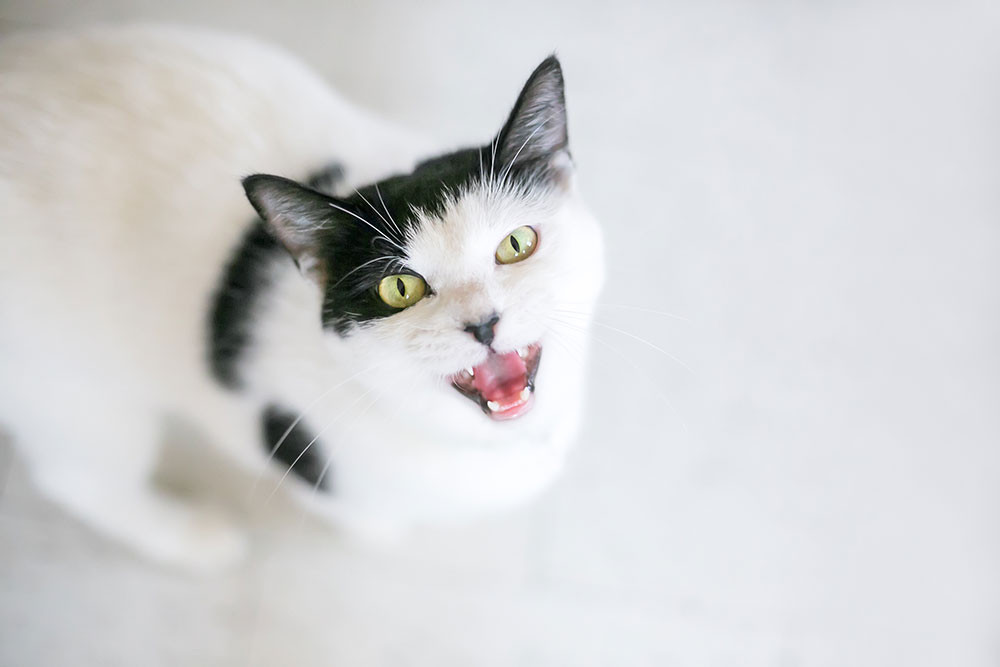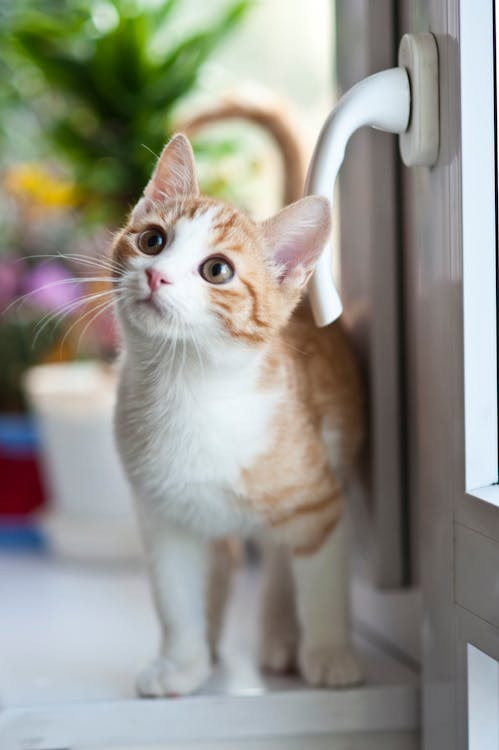Are you curious about what your cat is trying to tell you when it meows? At solcat.net, we decode your feline friend’s vocalizations, offering insights into their needs and emotions, helping you understand your furry companion better. Discover how to interpret different types of meows and create a stronger bond with your beloved cat, by learning about cat behavior, feline communication, and understanding your cat.
1. Understanding the Basics of Cat Meows
What Does It Mean When My Cat Meows? A cat’s meow is primarily a way to communicate with humans, and deciphering these vocalizations can greatly improve your relationship with your feline companion. Cats meow to express a variety of needs and emotions, ranging from simple requests to indications of distress.
1.1. Why Do Cats Meow Primarily at Humans?
Why do cats meow mostly at humans and not other cats? Cats primarily meow at humans because they learn that it’s an effective way to get our attention and communicate their needs, developing this behavior specifically for us. According to a study by the Cornell Feline Health Center in July 2023, adult cats rarely meow at each other, reserving this form of communication almost exclusively for humans, using meows to ask for food, attention, or to signal discomfort. This learned behavior is a testament to the close bond between cats and their owners.
1.2. The Different Types of Meows and Their Meanings
What are the different types of meows and what do they signify? The various types of meows each carry different meanings, from a short, cheerful greeting to a long, drawn-out demand. Here is a breakdown:
- Short Meow: Often a simple greeting, like a friendly “hello.”
- Multiple Meows: Usually indicates excitement or enthusiastic anticipation, such as when you’re preparing their meal.
- Mid-Pitched Meow: A general request for something, like wanting to be petted or played with.
- High-Pitched Meow: Can signify pain, fear, or urgent need, requiring immediate attention.
- Low-Pitched Meow: Usually expresses displeasure or unhappiness, like being left alone for too long.
- Drawn-Out Meow (Yowl): Often indicates a more serious issue, such as discomfort, stress, or a need for attention.
 A tabby cat looking attentively with its mouth slightly open, as if meowing.
A tabby cat looking attentively with its mouth slightly open, as if meowing.
1.3. How Does a Cat’s Age Affect Meowing?
How does a cat’s age influence its meowing behavior? A cat’s age significantly affects its meowing habits; kittens meow frequently to communicate with their mothers, while older cats might meow due to age-related issues like cognitive dysfunction. Kittens use meows extensively to signal hunger, discomfort, or the need for attention. As cats mature, they generally meow less to each other but continue to meow at humans. Senior cats may meow more due to cognitive decline, anxiety, or physical discomfort, requiring attentive care and veterinary consultation.
2. Decoding the Reasons Behind Excessive Meowing
Why is my cat meowing so much? Excessive meowing in cats can stem from various underlying causes, including medical issues, behavioral problems, or environmental factors. Identifying the specific reason is crucial for addressing the issue effectively and ensuring your cat’s well-being.
2.1. Medical Reasons for Increased Vocalization
Can medical issues cause a cat to meow more? Yes, medical issues can indeed lead to increased vocalization in cats; conditions such as hyperthyroidism, kidney disease, or cognitive dysfunction can cause a cat to meow excessively. According to the American Animal Hospital Association (AAHA), hyperthyroidism, a common condition in older cats, can cause increased appetite, thirst, and vocalization. Kidney disease can also lead to discomfort and increased meowing. Cognitive dysfunction, similar to dementia in humans, can cause confusion and excessive meowing, especially at night. If your cat suddenly starts meowing more, consult with your veterinarian to rule out any underlying health problems.
2.2. Behavioral Reasons for Constant Meowing
What are the behavioral reasons that might cause a cat to meow constantly? Behavioral issues, such as attention-seeking, boredom, or anxiety, can significantly contribute to a cat’s constant meowing. Cats often learn that meowing gets them attention, whether it’s food, play, or simply a cuddle. If a cat is bored or lacks mental stimulation, it may meow to initiate interaction. Anxiety, especially separation anxiety, can also cause excessive meowing when the owner is away. Addressing these behavioral reasons involves providing plenty of playtime, mental enrichment, and consistent attention to reduce anxiety.
2.3. Environmental Factors Influencing Meowing
How do environmental factors affect a cat’s meowing behavior? Environmental factors, such as changes in the home, new pets, or loud noises, can significantly influence a cat’s meowing behavior, often leading to increased vocalization due to stress or insecurity. Cats are sensitive to their surroundings, and any disruption can cause anxiety. A new baby, moving furniture, or even a change in routine can trigger excessive meowing. Providing a stable and secure environment, along with safe spaces where the cat can retreat, can help minimize environmentally induced meowing.
3. Practical Steps to Address Excessive Meowing
How can I stop my cat from meowing so much? Addressing excessive meowing in cats involves a combination of medical evaluation, behavioral adjustments, and environmental modifications to identify and resolve the underlying cause. Here are some practical steps:
3.1. Consulting with Your Veterinarian
When should I take my cat to the vet for excessive meowing? You should consult with your veterinarian if your cat suddenly starts meowing excessively, especially if there are other accompanying symptoms such as changes in appetite, litter box habits, or behavior. A vet can rule out medical conditions like hyperthyroidism, kidney disease, or pain that could be causing the increased vocalization. Early diagnosis and treatment of any underlying health issues can often resolve the excessive meowing.
3.2. Modifying Your Cat’s Environment
How can I change my cat’s environment to reduce meowing? Modifying your cat’s environment by providing more enrichment, safe spaces, and consistent routines can significantly reduce excessive meowing. Ensure your cat has plenty of toys, scratching posts, and climbing structures to keep them entertained and mentally stimulated. Create safe spaces where your cat can retreat when feeling stressed or anxious, such as a quiet room or a comfortable bed. Keeping a consistent daily routine for feeding, playing, and sleeping can also help reduce anxiety and meowing.
3.3. Behavioral Training Techniques
What behavioral training techniques can help reduce excessive meowing? Employing behavioral training techniques, such as ignoring attention-seeking meows, rewarding quiet behavior, and using puzzle feeders, can effectively reduce excessive meowing in cats. If your cat is meowing for attention, avoid giving them what they want when they meow. Instead, reward them when they are quiet and calm. Puzzle feeders can provide mental stimulation and keep your cat occupied, reducing boredom-related meowing. Consistency is key to successfully modifying your cat’s behavior.
 A close-up of a cat's face, showing its eyes and whiskers, emphasizing its expressive features.
A close-up of a cat's face, showing its eyes and whiskers, emphasizing its expressive features.
4. The Role of Diet and Nutrition in Meowing
Can a cat’s diet affect how much it meows? Yes, a cat’s diet and nutrition can play a significant role in their meowing behavior, with deficiencies or improper feeding schedules potentially leading to increased vocalization. Ensuring your cat receives a balanced and appropriate diet is crucial for their overall health and behavior.
4.1. Nutritional Deficiencies and Their Impact
How do nutritional deficiencies impact a cat’s meowing behavior? Nutritional deficiencies can impact a cat’s meowing behavior by causing discomfort, increased appetite, or overall health issues that lead to more vocalization. Cats need a balanced diet containing the right amounts of protein, fats, vitamins, and minerals. Deficiencies in certain nutrients can lead to health problems that cause pain or discomfort, prompting the cat to meow more. Ensure your cat’s diet is complete and balanced, and consult with your veterinarian if you suspect any nutritional deficiencies.
4.2. The Importance of Regular Feeding Schedules
Why are regular feeding schedules important for managing a cat’s meowing? Regular feeding schedules are crucial for managing a cat’s meowing because they help establish a routine and reduce food-seeking behavior. Cats thrive on predictability, and knowing when their next meal is coming can reduce anxiety and associated meowing. Feeding your cat at the same times each day can help regulate their appetite and prevent them from meowing excessively for food.
4.3. Special Diets for Specific Needs
Are there special diets that can help reduce meowing in cats? Yes, there are special diets that can help reduce meowing in cats, particularly those formulated for sensitive stomachs, allergies, or specific health conditions like hyperthyroidism. If your cat has food sensitivities or allergies, a hypoallergenic diet can alleviate discomfort and reduce meowing. For cats with hyperthyroidism, a diet low in iodine can help manage the condition and decrease vocalization. Consult with your veterinarian to determine the best diet for your cat’s specific needs.
5. Understanding Meowing in Senior Cats
Why do older cats meow more? Understanding meowing in senior cats is essential, as older cats often meow more due to age-related issues such as cognitive dysfunction, sensory decline, or physical discomfort. Recognizing the reasons behind this behavior can help you provide the best care for your aging feline companion.
5.1. Cognitive Dysfunction and Meowing
How does cognitive dysfunction affect meowing in older cats? Cognitive dysfunction, similar to dementia in humans, can significantly affect meowing in older cats, leading to increased vocalization, especially at night, due to confusion and disorientation. Cats with cognitive dysfunction may forget where they are, become easily disoriented, and experience changes in their sleep-wake cycle. This can result in excessive meowing as they try to make sense of their surroundings. Providing a stable environment, mental stimulation, and veterinary care can help manage the symptoms of cognitive dysfunction.
5.2. Sensory Decline and Communication
How does sensory decline influence a senior cat’s meowing? Sensory decline, such as hearing or vision loss, can influence a senior cat’s meowing by causing them to vocalize more to compensate for their diminished senses and seek reassurance. Cats rely heavily on their senses to navigate their environment, and when these senses decline, they may become anxious and insecure. Meowing can be a way for them to communicate their needs and seek attention. Ensuring your home is safe and accessible, and providing extra attention and reassurance, can help ease their anxiety.
5.3. Managing Age-Related Anxiety
What are the best ways to manage age-related anxiety that causes meowing? Managing age-related anxiety in senior cats, which often leads to increased meowing, involves providing a calm, predictable environment, offering plenty of affection, and consulting with a veterinarian about potential medical or behavioral interventions. Create a safe and comfortable space for your cat, free from loud noises and sudden changes. Spend quality time with your cat, offering gentle petting and reassurance. In some cases, medication or supplements may be recommended to help manage anxiety.
6. The Social Aspects of Cat Meowing
Is meowing a social behavior for cats? Meowing is primarily a social behavior that cats have developed to communicate with humans, using it to express their needs, desires, and emotions. Understanding the social context of meowing can help you better interpret what your cat is trying to tell you.
6.1. Meowing as a Learned Behavior
How is meowing a learned behavior in cats? Meowing is a learned behavior in cats, developed specifically to communicate with humans, as cats quickly learn that meowing gets them attention, food, or other desired outcomes. Kittens meow to their mothers, but adult cats rarely meow to each other. Instead, they reserve meowing for humans, using it as a tool to get their needs met. By responding to their meows, we reinforce this behavior, making it a primary means of communication.
6.2. The Role of Attention in Encouraging Meowing
How does giving attention affect a cat’s meowing habits? Giving attention to a cat when it meows can inadvertently encourage more meowing, as the cat learns that vocalization leads to interaction and reinforces the behavior. If your cat meows and you immediately respond with food, play, or affection, they will associate meowing with getting what they want. To manage this, try to ignore attention-seeking meows and only reward quiet behavior.
6.3. Creating a Communication System with Your Cat
How can I create a better communication system with my cat? Creating a communication system with your cat involves observing their meows, body language, and behavior to understand their needs and responding in a way that reinforces positive communication. Pay attention to the context of your cat’s meows. Are they meowing at the door, near their food bowl, or while looking at you? Use positive reinforcement to reward desired behaviors and ignore attention-seeking meows. Over time, you can develop a better understanding of your cat’s unique communication style.
7. Specific Meowing Scenarios and What They Mean
What does it mean when my cat meows in specific situations? Understanding what your cat’s meows mean in specific situations can help you respond appropriately and address their needs effectively. Here are some common scenarios:
7.1. Meowing at the Door
Why does my cat meow at the door? A cat meowing at the door typically indicates that they want to go outside, come inside, or are seeking attention because they are bored or lonely. If your cat is an indoor-outdoor cat, they may be meowing to signal that they want to go outside. If they are indoors, they may be meowing to come in. Alternatively, they may simply want your attention and know that meowing at the door will get you to interact with them.
7.2. Meowing at Feeding Time
What does it mean when my cat meows around feeding time? Meowing around feeding time usually means your cat is hungry and wants to be fed, having learned to associate meowing with the anticipation of food. Cats quickly learn that meowing will prompt their owners to provide food. To manage this behavior, establish a regular feeding schedule and avoid giving in to their demands outside of those times.
7.3. Meowing at Night
Why does my cat meow at night? A cat meowing at night can be due to various reasons, including boredom, hunger, cognitive dysfunction, or seeking attention. If your cat is bored, provide them with plenty of playtime and enrichment during the day to tire them out. If they are hungry, consider using an automatic feeder to provide a small meal overnight. Senior cats may be meowing due to cognitive dysfunction, requiring veterinary evaluation and management.
8. Tools and Resources for Understanding Cat Behavior
What tools and resources can help me understand my cat’s behavior better? There are numerous tools and resources available to help you understand your cat’s behavior better, from books and websites to behaviorists and veterinary specialists. Utilizing these resources can provide valuable insights into your cat’s unique communication style.
8.1. Books and Websites
What are some helpful books and websites about cat behavior? Several books and websites offer valuable information about cat behavior, including understanding meows, body language, and overall feline communication. Some recommended resources include:
- “The Cat Whisperer” by Mieshelle Nagelschneider: Provides insights into understanding and resolving cat behavior issues.
- “Think Like a Cat” by Pam Johnson-Bennett: Offers practical advice on understanding cat behavior and creating a harmonious home.
- Cornell Feline Health Center: A reliable source for information on cat health and behavior.
- solcat.net: Offers a wealth of articles and resources on cat care, behavior, and health.
8.2. Consulting with a Cat Behaviorist
When should I consult with a cat behaviorist? You should consider consulting with a cat behaviorist if you are struggling to understand or manage your cat’s behavior, especially if the behavior is causing stress for you or your cat. A behaviorist can provide a professional assessment of your cat’s behavior, identify underlying issues, and develop a customized plan to address the problems. They can also offer guidance on how to modify your environment and interact with your cat to promote positive behavior.
8.3. Veterinary Behavior Specialists
What is the difference between a cat behaviorist and a veterinary behavior specialist? A cat behaviorist typically has a background in animal behavior and can provide guidance on managing behavioral issues, while a veterinary behavior specialist is a licensed veterinarian with specialized training in animal behavior and can address medical and behavioral issues. Veterinary behavior specialists can prescribe medication and diagnose underlying medical conditions that may be contributing to the behavior problem. If you suspect your cat’s meowing is related to a medical issue, consulting with a veterinary behavior specialist is recommended.
9. The Importance of Patience and Observation
Why are patience and observation important when trying to understand my cat’s meows? Patience and observation are crucial when trying to understand your cat’s meows because each cat is unique, and understanding their specific communication style takes time and attention. By being patient and observing your cat’s behavior in different situations, you can begin to identify patterns and understand what they are trying to communicate.
9.1. Recognizing Individual Cat Personalities
How does recognizing a cat’s individual personality help in understanding its meows? Recognizing a cat’s individual personality helps in understanding its meows because each cat has a unique way of communicating, and their meows are influenced by their temperament and experiences. Some cats are naturally more vocal, while others are quieter. Understanding your cat’s personality can help you interpret their meows more accurately and respond in a way that meets their needs.
9.2. Keeping a Meowing Diary
What is a meowing diary and how can it help? A meowing diary is a log where you record when your cat meows, the context in which they meow, and your response, helping you identify patterns and understand what your cat is trying to communicate. By keeping a diary, you can track when your cat meows, what they are doing at the time, and what you do in response. This can help you identify triggers for their meowing and develop strategies to address the underlying issues.
9.3. Celebrating Small Victories
Why is it important to celebrate small victories when addressing excessive meowing? Celebrating small victories when addressing excessive meowing is important because it reinforces positive changes in behavior and motivates you to continue working towards a solution. Modifying a cat’s behavior takes time and consistency, and it’s important to acknowledge and celebrate even small improvements. This can help you stay positive and committed to helping your cat.
10. Creating a Harmonious Environment for a Quieter Cat
How can I create a harmonious environment that leads to a quieter cat? Creating a harmonious environment involves providing a stable, enriching, and secure space for your cat, addressing their physical and emotional needs to reduce stress and excessive meowing. This includes providing plenty of enrichment, consistent routines, and a safe and comfortable home.
10.1. Enriching Your Cat’s Life
What are some ways to enrich my cat’s life and reduce meowing? Enriching your cat’s life can significantly reduce meowing by providing mental and physical stimulation that reduces boredom and anxiety. Provide a variety of toys, scratching posts, and climbing structures to keep your cat entertained. Rotate toys regularly to keep them interested. Puzzle feeders can provide mental stimulation and slow down eating. Spend time playing with your cat each day to strengthen your bond and provide exercise.
10.2. Providing a Predictable Routine
How does a predictable routine help reduce meowing? Providing a predictable routine helps reduce meowing by creating a sense of security and stability, minimizing anxiety and the need to vocalize for attention or reassurance. Cats thrive on routine, and knowing what to expect each day can help them feel more secure. Establish consistent feeding times, playtimes, and sleeping arrangements to create a predictable routine.
10.3. Creating Safe Spaces for Your Cat
Why is it important to create safe spaces for my cat to reduce meowing? Creating safe spaces is crucial for reducing meowing, as it provides your cat with a secure retreat where they can feel comfortable and reduce anxiety-related vocalization. Cats need a place where they can go to feel safe, especially when they are feeling stressed or overwhelmed. This could be a quiet room, a comfortable bed, or a cat tree. Make sure your cat has access to these safe spaces at all times.
 A cat lying comfortably in a cozy bed, showcasing a safe and relaxing environment.
A cat lying comfortably in a cozy bed, showcasing a safe and relaxing environment.
By understanding the nuances of your cat’s meows and addressing their underlying needs, you can create a stronger bond and a more harmonious living environment. Visit solcat.net for more insights and resources on cat care and behavior, and join our community of cat lovers in the USA!
Contact us:
Address: 950 Alaskan Way, Seattle, WA 98104, United States
Phone: +1 (206) 386-4000
Website: solcat.net
FAQ: Decoding Cat Meows
1. Why Does My Cat Meow at Me When I Am on the Phone?
Your cat meows when you are on the phone primarily to get your attention, as they sense you are engaged but not with them. They may also be curious about the sounds and want to investigate, or they might feel neglected and seek reassurance.
2. What Does It Mean When My Cat Meows and Rubs Against My Legs?
When your cat meows and rubs against your legs, it’s a sign of affection and a way to mark you with their scent, indicating they consider you part of their family. They are also likely seeking attention and wanting to be petted.
3. Is It Normal for Cats to Meow Excessively?
Excessive meowing is not always normal and can be a sign of underlying medical or behavioral issues. It’s important to consult with a veterinarian to rule out any health problems and address any potential anxiety or attention-seeking behaviors.
4. How Can I Tell If My Cat’s Meowing Is a Sign of Pain?
If your cat’s meowing is accompanied by other signs of discomfort, such as limping, hiding, or changes in appetite, it may be a sign of pain. High-pitched or distressed meows should also be taken seriously and warrant a visit to the vet.
5. Can Changing My Cat’s Food Reduce Meowing?
Changing your cat’s food may reduce meowing if they have a food sensitivity or allergy causing discomfort. A high-quality, balanced diet can also help regulate their appetite and prevent hunger-related meowing.
6. Why Does My Cat Meow Loudly at Night?
Loud meowing at night can be due to boredom, hunger, cognitive dysfunction, or seeking attention. Provide plenty of daytime stimulation, consider a late-night snack, and consult with a vet to rule out any medical issues.
7. How Do I Stop My Cat From Meowing for Attention?
To stop attention-seeking meowing, ignore the behavior and only reward quiet moments with attention. Ensure your cat has plenty of enrichment and playtime to reduce boredom and the need for attention.
8. What Should I Do If My New Cat Meows Constantly?
If your new cat meows constantly, it may be due to anxiety, unfamiliarity with their surroundings, or seeking comfort. Provide a safe and quiet space, offer plenty of reassurance, and give them time to adjust to their new home.
9. Does Neutering/Spaying Affect a Cat’s Meowing?
Neutering or spaying can reduce meowing related to mating behaviors, as it eliminates the hormonal urges that drive vocalization in search of a partner.
10. Is It Possible to Teach My Cat to Meow Less?
Yes, it’s possible to teach your cat to meow less by ignoring attention-seeking meows, rewarding quiet behavior, and providing plenty of enrichment to address the underlying causes of excessive vocalization.

